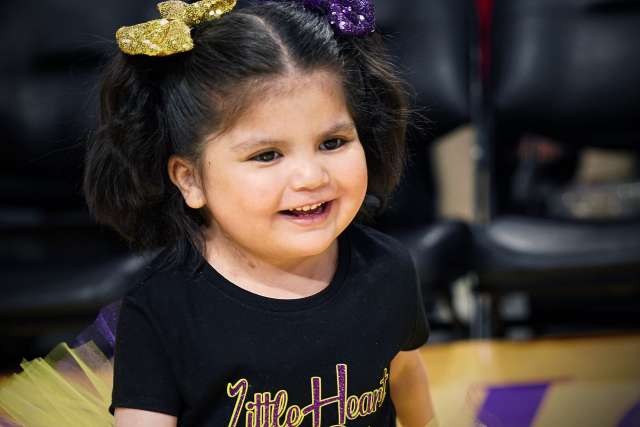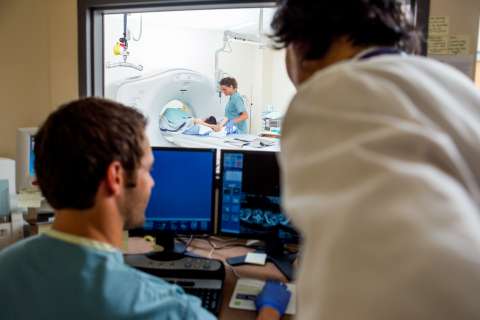Four-year-old Olivia Lopez spent nearly all of 2023 hospitalized at UCLA Mattel Children’s Hospital, first awaiting a new heart and then recovering from the transplant surgery. Soon after being admitted, she suffered a stroke that paralyzed the right side of her body.
But in August, less than a year after the transplant, Olivia is expected to be ready to start kindergarten – a milestone that her mom, Irene, attributes to the medical expertise at UCLA Health and that Olivia’s doctor also attributes to Olivia herself.
From the outset, a mother’s determination
First, though, came Irene Lopez’s own perseverance.
The initial indication of trouble came during an ultrasound when Lopez was 18 weeks pregnant with Olivia.
“Only half her heart was working, and there was a huge hole in it,” Lopez said. In addition, she was told that Olivia’s heart was positioned on the right side of the chest rather than the left. Olivia would need a pacemaker right after birth, and even then, the longer-term outlook was unclear.
But Lopez was determined to give Olivia every chance to survive. “She already had her own little personality,” said Lopez, describing Olivia as waving on her ultrasound. “I had hope,” Lopez said simply.
By this point, Lopez, who lives in Coachella, was being seen by a high-risk obstetrician in Orange County, three hours away. Every two weeks, she traveled there for an ultrasound to check for potential fluid build-up in Olivia’s heart and to monitor her heart rate, which was already substantially lower than the normal range of 110-160 beats per minute.
At Lopez’s 36-week ultrasound, Olivia’s heart rate was found to be “in the low 40s,” Lopez said. “The doctor said, ‘You need to go to the hospital – you’re going to have a baby,’” she recalled.
Lopez was immediately hospitalized and a steroid was administered to help Olivia’s lungs develop a bit more. Three days later, Olivia was delivered via cesarean section at UCI Medical Center in Irvine, then rushed to Children’s Hospital of Orange County (CHOC). The following day, Olivia had a pacemaker implanted in her heart to keep it beating regularly,
“The first whole month, she was in an induced coma,” Lopez said. “It was touch and go at first.”
It took two months until Olivia was stable enough to come home.
Then, at six months, Olivia needed another surgery at CHOC – this time, to put a temporary patch over the hole in her heart. “It was basically to enable her to keep her own heart,” Lopez explained. The hope was that her heart would last until she was about 5, delaying the need for a transplant.
A dramatic slide
But not long after she turned 3, Olivia began to decline. Her lips, which were always purple due to a lack of adequate oxygen in her blood, began to deepen to a darker hue. She was also weakening and was vomiting frequently. Two hospitalizations later, Olivia still wasn’t any better.
Then Lopez, who’d been tracking Olivia’s oxygen levels using a fingertip pulse oximeter, realized that she wasn’t even able to get a stable reading. She and Olivia set out for another long drive to CHOC, in Orange, but Lopez quickly realized her daughter wasn’t likely to survive the trip and stopped instead at nearby Eisenhower Medical Center in Rancho Mirage.
Olivia had suffered complete heart failure. After she was stabilized she was airlifted to CHOC, but it became apparent she needed a higher level of care. About a week later, in January 2023, she was transferred to UCLA Health.
The wait for a new heart
By this point, “the only option for her was a transplant,” said Juan Alejos, MD, medical director of the Pediatric Heart Transplant/Cardiomyopathy program at UCLA Health and clinical professor in pediatric cardiology at the David Geffen School of Medicine at UCLA.
Doctors at UCLA Health perform about 15 pediatric heart transplants a year.
Learn more about the Pediatric Heart Transplant program
Because of her condition, Olivia was immediately placed on an external blood pump that could take over for her heart temporarily. Then, as soon as she was stabilized, she was transferred to a more sophisticated long-term ventricular assist device that required a more invasive surgery.
In the interim, Olivia suffered a stroke due to a blood clot that caused partial paralysis to her right side.
Meanwhile, Lopez, a single parent with a full-time job and another child at home in Coachella, stayed at UCLA Mattel Children’s Hospital with Olivia on her days off. Lopez’s mother (Olivia’s grandmother) stayed with her the rest of the time, the two of them also coordinating weekly visits by Olivia’s older brother, Eli.
Finally, by September, Lopez was informed that a suitable heart had been found for Olivia. On Sept. 23, Glen Van Arsdell, MD, chief of congenital cardiovascular surgery, performed the transplant, a lengthy procedure that was even more complex than usual given the location of her heart on the right side of her chest. This meant that all of the large veins and arteries connected to the heart that had to be rerouted “weren’t necessarily in the right place,” Dr. Alejos said.
In addition, the new heart had to be rotated so that it would fit in the existing space.
Pediatric heart transplants are rare – only about 500 take place each year in the country. UCLA Health averages about 15 pediatric heart transplants a year, but situations such as Olivia’s are more complicated than most, Dr. Alejos said.
“She would be classified as a moderate- to high-risk transplant because of her anatomy,” he explained. “The fact that we have a very skilled set of congenital heart surgeons makes a surgery like hers possible.”
Feisty and determined
After some initial severe setbacks related to the anti-rejection medications she was given following the transplant, Olivia was finally able to return home in December 2023.
Since then, the change in Olivia has been dramatic. “She’s thriving,” Lopez said. Although Olivia had been taking about 15 different medications, some of them are already being reduced, Lopez said.
Olivia is also getting physical therapy and has been making significant improvements. Because her foot doesn’t bend normally and sometimes drags, it can cause her to fall, Lopez explained. However, she’s now able to walk, and Lopez was able to teach her how to climb on and off the bed.
As a result of the stroke, Olivia’s right arm had been frozen in a bent position with her fist pushing up against her chin. With therapy and with Lopez regularly massaging her arm and her hand, Olivia’s arm has relaxed enough so it’s at about a 90-degree angle, and her fist has relaxed so her nails are no longer digging into her palm.
“Little by little, she’s doing it,” Lopez said.
Olivia often comes up with workarounds, such as learning to open a jar by sitting down and holding it in place with her feet so she can twist it open with her left hand.
Although she had speech delays, Olivia has also made tremendous strides in her verbal skills. “She’s trying to sing the ‘Frozen’ songs now,” Lopez said, “and the words she says are much clearer.”
“She’s a very spunky little girl,” Dr. Alejos said. “She has a lot of fight in her. She was pretty well known in the ICU for her feistiness.”
That’s a good thing, he said: “Her personality is probably what helped her pull through.”
Olivia was well known during her many months at UCLA Mattel Children’s Hospital: even the cleaning staff would regularly say hello to her, said Lopez, adding that she was grateful for everyone at UCLA who was part of her daughter’s journey.
Olivia was recently honored as a Laker for a Day as part of UCLA Health’s ongoing partnership with the Los Angeles Lakers. Despite the private suite, the chance to meet the cheerleaders and getting to run around on the court and even sit courtside to watch the players come out at the start of the game, her favorite part was probably the food, Lopez said, laughing.
The Lakers organization had made sure to stock the suite with her favorite foods, including chicken tenders, french fries and ranch dressing. (Although Olivia still relies on a gastric tube for much of her nutrition, she’s able to eat some food.)
Next up for Olivia, who turns 5 in July: kindergarten, and maybe even a bit of preschool later this spring to allow her to spend time with children her own age.
For now, though, Lopez is still struck on a daily basis by how much Olivia has been transformed since receiving a new heart. From her lips down to her toenails, “she’s just so pink now,” Lopez said. “She’s not purple and blue and gray. It’s just so amazing, I want to start crying.”
Lopez, who’s keenly aware that organ transplants such as Olivia’s come about because another family has experienced the loss of a child, hopes donor families understand what a profound impact they have.
“They’re not just saving one life,” Lopez said. “They’re saving the life of an entire family.”





